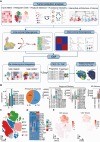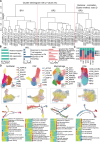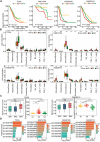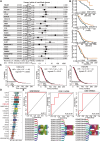Effect of fibroblast heterogeneity on prognosis and drug resistance in high-grade serous ovarian cancer
- PMID: 39496775
- PMCID: PMC11535537
- DOI: 10.1038/s41598-024-77630-0
Effect of fibroblast heterogeneity on prognosis and drug resistance in high-grade serous ovarian cancer
Abstract
Tumor heterogeneity is associated with poor prognosis and drug resistance, leading to therapeutic failure. Here, we used tumor evolution analysis to determine the intra- and intertumoral heterogeneity of high-grade serous ovarian cancer (HGSOC) and analyze the correlation between tumor heterogeneity and prognosis, as well as chemotherapy response, through single-cell and spatial transcriptomic analysis. We collected and curated 28 HGSOC patients' single-cell transcriptomic data from five datasets. Then, we developed a novel text-mining-based machine-learning approach to deconstruct the evolutionary patterns of tumor cell functions. We then identified key tumor-related genes within different evolutionary branches, characterized the microenvironmental cell compositions that various functional tumor cells depend on, and analyzed the intra- and intertumoral heterogeneity as well as the tumor microenvironments. These analyses were conducted in relation to the prognosis and chemotherapy response in HGSOC patients. We validated our findings in two spatial and seven bulk transcriptomic datasets (total: 1,030 patients). Using transcriptomic clusters as proxies for functional clonality, we identified a significant increase in tumor cell state heterogeneity that was strongly correlated with patient prognosis and treatment response. Furthermore, increased intra- and intertumoral functional clonality was associated with the characteristics of cancer-associated fibroblasts (CAFs). The spatial proximity between CXCL12-positive CAFs and tumor cells, mediated through the CXCL12/CXCR4 interaction, was highly positively correlated with poor prognosis and chemotherapy resistance in HGSOC. Finally, we constructed a panel of 24 genes through statistical modeling that correlate with CXCL12-positive fibroblasts and can predict both prognosis and the response to chemotherapy in HGSOC patients. Our study offers insights into the collective behavior of tumor cell communities in HGSOC, as well as potential drivers of tumor evolution in response to therapy. There was a strong association between CXCL12-positive fibroblasts and tumor progression, as well as treatment outcomes.
Keywords: CXCL12; HGSOC; Tumor cell state; cancer-associated fibroblasts; functional clonality; microenvironment; spatiotemporal transcriptome; tumor evolution; tumor transcriptomic heterogeneity.
© 2024. The Author(s).
Conflict of interest statement
The authors declare no competing interests.
Figures







References
-
- Silva, R. et al. Unveiling the epigenomic mechanisms of acquired platinum-resistance in high-grade serous ovarian cancer. Int. J. Cancer153, 120–132. 10.1002/ijc.34496 (2023). - PubMed
MeSH terms
Substances
Grants and funding
LinkOut - more resources
Full Text Sources
Medical

